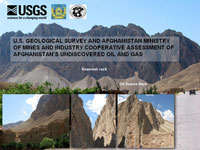Energy Sources
The U.S. Geological Survey (USGS) Energy Resources Program (ERP) provides information from impartial, comprehensive research investigations of geologic energy resources, including: petroleum (oil, natural gas, natural gas liquids), coal, gas hydrates, geothermal resources, oil shale, oil sands, uranium, and heavy oil and natural bitumen. Information from these investigations advances the understanding of geologic processes and the economic, technical, and environmental factors affecting energy resource occurrence, availability, and recoverability. This understanding facilitates the development of sound policies on domestic and foreign energy resources, and the responsible management of energy resources on Federal lands.
Presently, coal is used to generate more than half of the electricity in the U.S. In response to the increasing demand for coal and for cleaner electric power generation, USGS research efforts yield modern, digital assessments of the quantity, quality, location, and accessibility of the Nation’s coal resources.
Oil and Gas Resources
 The ERP uses a total petroleum systems approach to evaluate the probable presence of undiscovered,subsurface accumulations of oil and natural gas resources in the U.S. and around the world. Research projects using this approach provide the basis for estimating resource volumes in conventional and unconventional (continuous) oil and natural gas accumulations, including coalbed methane and gas from low-permeability geologic units such as ‘tight gas sands.’ These scientific activities yield geologically based estimates (assessments) of undiscovered, technically recoverable oil and gas resource endowments. Technically recoverable resources can be produced using currently available technology.
The ERP uses a total petroleum systems approach to evaluate the probable presence of undiscovered,subsurface accumulations of oil and natural gas resources in the U.S. and around the world. Research projects using this approach provide the basis for estimating resource volumes in conventional and unconventional (continuous) oil and natural gas accumulations, including coalbed methane and gas from low-permeability geologic units such as ‘tight gas sands.’ These scientific activities yield geologically based estimates (assessments) of undiscovered, technically recoverable oil and gas resource endowments. Technically recoverable resources can be produced using currently available technology.
The forecast increase in future energy demand will likely generate interest in all energy resources. The ERP investigates geologic processes affecting the quality and distribution of other energy resources such as geothermal energy, and non-traditional fuels such as gas hydrates, uranium, oil shale, oil sands (tar sands), and heavy oil and natural bitumen. These resources may be poised to assume a more prominent role in the Nation’s energy mix in the coming years.